Flour 101: Different Types of Flour and When to Use Them
Different types of flour for baking and the fundamental differences between them. An approachable baking science guide and reference post on baking flour.
We’re talking about flour today! All different types of flour, as well as when and why you would use them for different baking applications.
This post is going to get a bit nerdy and technical (remember this salt post?), but I love when that happens. In an effort to keep things simple, this post is focused on baking flour varieties produced from various strains of wheat. All of the flour varieties described below are standard flours available in most grocery stores.
If you enjoy understanding the whys and hows of baking, you will love this post. If you’ve ever wondered the difference between bread flour and all purpose flour, what pastry flour is and why you would use it, or why cake flour produces light-as-air sponge cakes, this post is for you. I’m going to break it all down. This is a monster of a post, but it is packed with information.
Let’s get started…
Wheat: The Basics
Wheat flours are produced by milling wheat kernels (aka. wheat berries – the same ones you see in the bulk bins of your grocery store!) of various strains of wheat. I use Bob’s Red Mill flours in my own kitchen (you can read more about why here). The gluten percentages described in this post are specific to their brand and milling specifications, but are generally consistent with other brands of flour. As flours naturally age, gluten and protein increases. These qualities are desirable, but naturally take time.
Wheat kernels are comprised of three basic parts: germ (the embryo), bran (the kernel shell), and endosperm. Wheat germ and wheat bran are high in natural oils, nutrients, fiber, and minerals. They also contain protein. In contrast, the endosperm consists primarily of protein and starch molecules.
All-purpose flours and refined flours are produced exclusively from the milling and grinding of the endosperm. The germ and bran are removed from these flours. The endosperm is broken into very small particles, or streams, and analyzed for protein and starch content. This information allows millers to create specific flour blends with certain baking characteristics. Stone-ground flours are the exception to the rule, as they can contain some germ and bran in the final product.
In comparison, whole wheat flours are produced from the milling of the entire wheat kernel (germ, bran, and endosperm). For this reason, whole wheat flours are generally higher in protein than all-purpose flours.
Understanding Gluten
Gluten is simply a term for the specific proteins (glutenins and gliadins) found in wheat. All proteins are comprised of chains of amino acids. In dry form, wheat proteins has little to no structure. When combined with water, these gluten proteins change shape, form bonds with one another, and produce tightly coiled, yet highly elastic structures. Imagine a slinky shape made up of wheat proteins.
Similar to a slinky, these protein structures have the ability to stretch to a large degree. The proteins can stretch and expand, yet inherently provide structure and shape. This unique characteristic of gluten allows us to create airy breads and pastries that hold their shape and chewy al dente pasta strands, among many other things. Gluten and it’s stretching ability allows us to make long thin sheets of puff pastry, among other things, that don’t break or crumble during rolling.
Very important note: While whole wheat flours do contain high quantities of protein and gluten, they generally produce weaker gluten strands (due to the presence of the bran and germ in the flour). Strong gluten strands allow for expansion and air. Weak gluten strands make this more difficult. This is why 100% whole wheat breads and pastries have a tendency to be denser in structure.
As you add more water to gluten, you produce more concentrated gluten. When this mixture is worked, stretched, or handled (think: kneading), the proteins stretch and become even more elastic. The less the mixture is worked, the less concentrated the gluten will be. Some types of baking benefit from the development of gluten (ie. bread or pizza doughs, pasta, puff pastry, etc.) and certain types of baking do not (ie. pancakes, baking powder/baking soda leavened batters, pie dough, cakes).
Depending on their own properties, other ingredients also have the ability to strengthen or weaken gluten. Understanding this is important for technique, as well as recipe development. For example, the ions in salt tend to increase gluten strength. Alternatively, larger volumes of sugar and fat (think: sweet pastries) will decrease overall gluten strength. Acidity can also have a weakening effect on gluten, which is why certain pastry dough recipes will recommend adding a touch of vinegar or lemon juice to doughs.
Different Types of Baking Flour + Why/When to Use Them
Certain strains of wheat (eg. hard red winter wheat) contain higher protein – aka. gluten – than other strains of wheat (eg. soft white wheat), and are used accordingly to create different types of flours.
I’ve included basic protein ranges for various flour types – as well as helpful reference guide at the bottom of this post. These protein percentages can vary significantly from brand to brand, but allow for consistency and reliability across bags and bags of flour, which is very important in baking. While each crop of wheat will vary, these protein thresholds below are set by Bob’s Red Mill and are used to test each shipment of wheat they receive:
Unbleached All-Purpose Flour (12% – 13% Protein)
The work horse of all flour blends and my basic flour of choice. Unless recipes specific other flour types, most baking recipes are created with the assumption that all-purpose flour will be used to make them. It is important to note that all-purpose flour in the United States is not the same thing as all-purpose flour in other countries (which can vary significantly in protein percentage).
All-purpose flour is generally produced from hard red winter wheat. It is refined, which means that the bran and germ are removed during milling. This produces a flour that is light in color and has a relatively mid-level protein amounts that can be used for most baking purposes.
Bleached All-Purpose Flour vs Unbleached All-Purpose Flour:
Unlike unbleached flours, bleached flours are chemically altered with bleaching agents (benzoyl peroxide or chlorine dioxide) to whiten flour and speed up production. They sometimes contain bromate to improve rise (ps. most countries outside the United States ban bromate) and elasticity too. Bleached flours were a quick solution to produce vast quantities of flour for the masses.
As a side effect of the bleaching process, bleached all purpose flours generally contain less protein than unbleached all purpose flour. Some pastry books will recommend it for this reason, as lower protein flours can produce more flaky baked goods. I rarely, if ever, use bleached flours.
In contrast, Bob’s Red Mill flours and other high-quality flours never contain chemicals and achieve a similar effect naturally by adding malted barley flour to their all-purpose flour, which improves rise and elasticity.
Bread Flour (12.5% – 15% Protein)
Bread flour is produced from hard red spring wheat, which is high in protein (unlike hard red winter wheat, which contains less protein). Like all-purpose flour, bread flour is refined and does not the bran or germ of the wheat kernel. The higher protein in bread flour allows more for increased gluten development when combined with water. Gluten allows doughs to expand, hold large amounts of air (think: lovely artisanal bread with delicious air pockets) and produce high rise.
More gluten development also improves chew (note: this is why durum wheat, which is incredibly high in protein, is used to produce most store-bought pasta). Some cookie recipes use bread flour in addition to all purpose flour for this purpose.
Higher protein flour – aka. bread flour – is beneficial to doughs and baked goods that require more elasticity and structure: yeast breads, pizza doughs, certain pastry doughs (puff pastry, strudel dough, etc.).
100% Whole Wheat Flour (13.5% Protein)
Unlike all-purpose flour, true whole wheat flours are produced from the milling of the entire wheat kernel (primarily hard red wheat). Aka. whole grain flour. Whole wheat flour contain the bran and germ, which produces a flour with a slightly darker color, stronger more nutty flavor, and higher nutritional content. This is especially true of stone ground whole wheat flours.
Since whole wheat flours contain the bran and germ, they are generally higher in protein than all-purpose flours. Despite its high protein content, the presence of the bran and germ makes it more difficult for whole wheat flour to produce as much gluten development and elasticity as all purpose flour or bread flour. This is why 100% whole wheat breads (and other baked goods) can be more dense and less airy in structure.
Flours with higher protein absorb more liquids than low protein flours. For this reason, it is important to adjust liquid amounts when using whole wheat flour in place of all purpose flour in most recipes. To improve the nutritional or enhance the flavor of baked goods – without affecting structure – you can substitute a small portion of all-purpose flour with equal quantities of whole wheat flour with little effect.
Storage: Since whole wheat flours contain the whole wheat kennel, they have a tendency to have a shorter shelf life than all-purpose flours. Unless I am going through a bag of whole wheat flour in a short period of time, I like to store my whole wheat flours in the freezer to preserve more nutrients and prolong its shelf life.
Pastry Flour
Unlike all of the other flours mentioned above, pastry flour is milled from a different strain of wheat: soft white wheat. Soft white wheat contains significantly less protein than red wheat. As a result, flours made from soft white wheat are lower in protein and produce less gluten development.
Low gluten development is preferable for baked goods that don’t benefit from increased elasticity: baking soda and baking powder leavened batters (quick breads, muffins, cakes, pancakes, etc.) and pie doughs. Lower gluten also produces more tender baked goods.
While unbleached refined pastry flour (aka. germ and bran is removed) is available and contains even less protein (roughly 9%) , whole wheat pastry flour (8% – 11% protein) is my go-to whole grain flour for baking. It gives you the best of both worlds, and I often substitute it 1:1 for all-purpose flour with great success (ex: this poppy seed bread). The difference to all purpose flour is indiscernible.
Whole wheat pastry flour allows you to produce tender, fluffy 100% whole grain baked goods — with all the added nutritional benefits — than whole wheat flour (13.5% protein) would generally allow.
100% White/Ivory Whole Wheat Flour (13% – 16% protein)
White whole wheat flour is relatively newer to the market, and is produced from white winter wheat kernels that are high in protein. Bob’s Red Mill’s version goes by the name of ivory whole wheat flour. As you can notice, it is actually higher in protein content than whole wheat flour.
White whole wheat flour is 100% whole grain and contains the bran, germ, and endosperm. However, since it is milled from naturally white wheat kernels, it is significantly lighter in color than whole wheat flour. It is also sweeter in flavor than whole wheat flour (yet offers the exact same nutritional benefits) and some people prefer it to whole wheat flour for this reason.
Since it is naturally high in protein, it works incredibly well as a whole grain alternative to bread flour or other baked goods that benefit from increased elasticity and gluten development (yeast dough, pizza, puff pastry, strudel dough, etc.). White/ivory whole wheat flour is less ideal for baked goods that benefit from tenderness, and for this reason I don’t use it in baking soda and baking powder leavened batters (quick breads, muffins, cakes, pancakes, etc.) and pie doughs.
Cake Flour (6.5% protein)
Last but not least, cake flour is generally milled from low protein wheat strains (sometimes these go by the name of club wheat). This yields minimal gluten development when combined with water. This is disastrous for some things (ie. bread) and amazing for baked goods, such as angel food cakes, genoise or sponge cake, biscuits, and lighter-than-air muffins.
Now that we’ve broken down the basics of gluten, it is easy to understand why using a flour with 6.5% protein vs. a flour with 12% to 13% protein (all purpose flour) would yield two completely different baked goods.
Cake flours are also milled and sifted to an extra fine texture. For this reason, they absorb liquids very quickly. Generic cake flours are bleached and cut with cornstarch (read the ingredients). Adding cornstarch effectively dilutes the protein/gluten of the flour even more (this is also the reasoning behind DIY cake flour – made by combining all purpose flour and cornstarch).
In contrast, Bob’s Red Mill cake flour is unbleached, contains no chemicals, and zero corn starch. I love it! While I don’t use cake flour that often, it has the ability to produce lighter-than-air baked goods.
Conclusion
As you can see, different types of flour are not created equal and are never truly interchangeable with one another. Once you understand the basic properties of various wheat flours, it gives you the ability to play around, create your own blends, and get creative in the kitchen. It also allows you to tailor baked goods to your own liking (texture, chew, flavor, etc.).
If you want to learn even more, here are handful of my favorite cooking resources [affiliate links]:
- On Food and Cooking: The Science and Lore of the Kitchen by Harold McGee
- Cookwise: The Hows & Whys of Successful Cooking by Shirley O. Corriher
- The Pie and Pastry Bible by Rose Levy Beranbaum
- The Professional Pastry Chef: Fundamentals of Baking and Pastry by Bo Friberg
- Ratio: The Simple Does Behind the Craft of Everyday Baking by Michael Ruhlman
Find more kitchen essentials posts here.

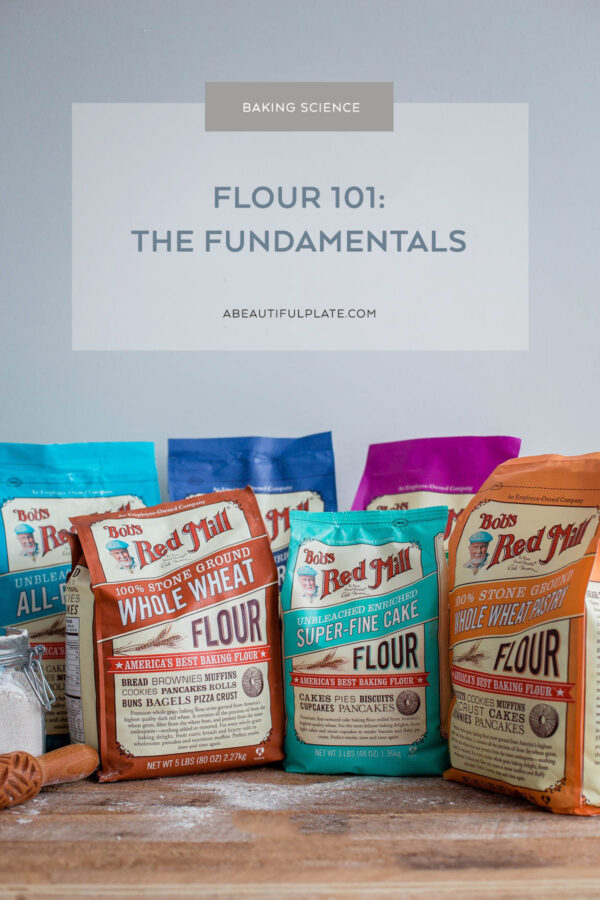
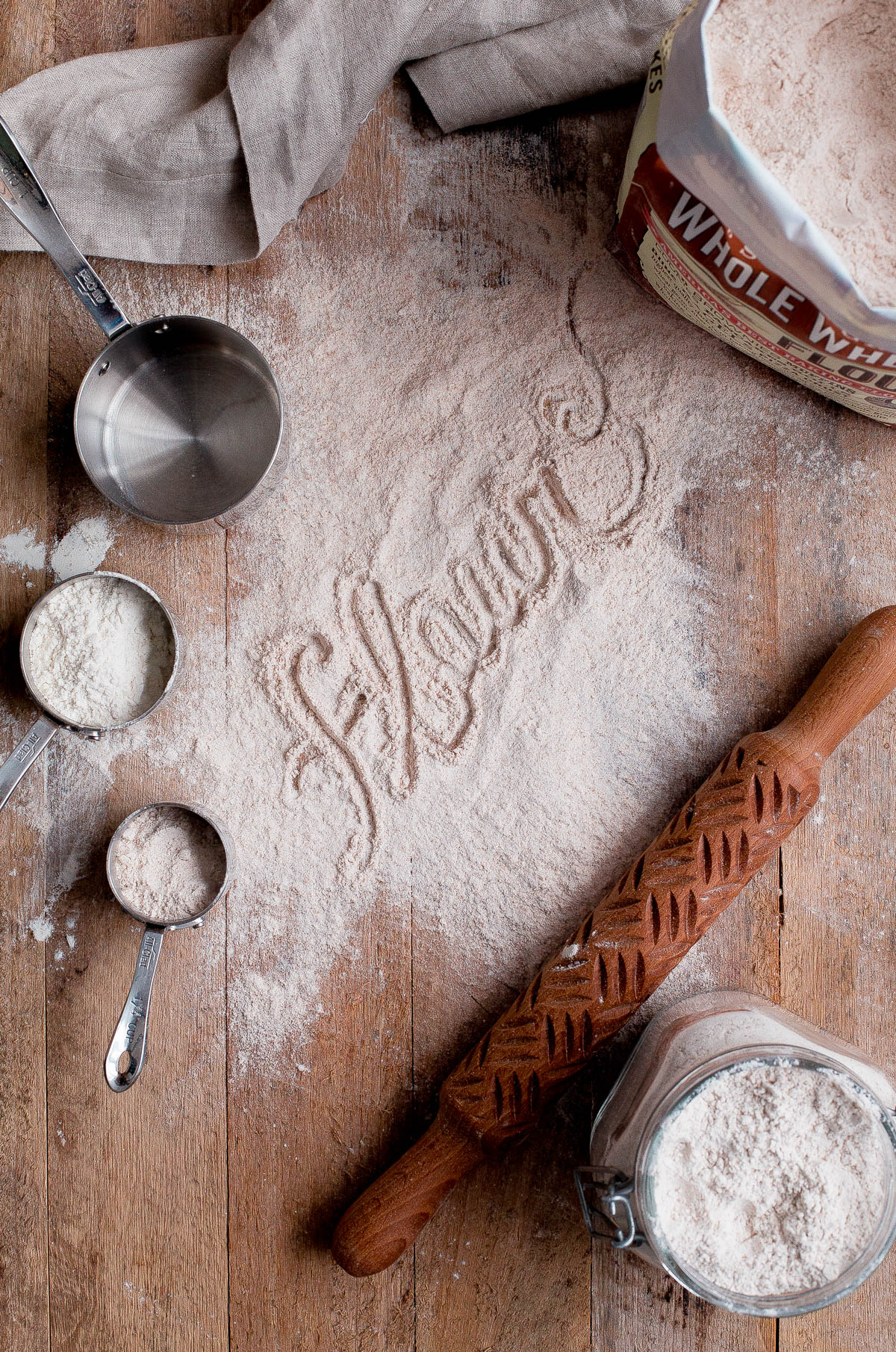
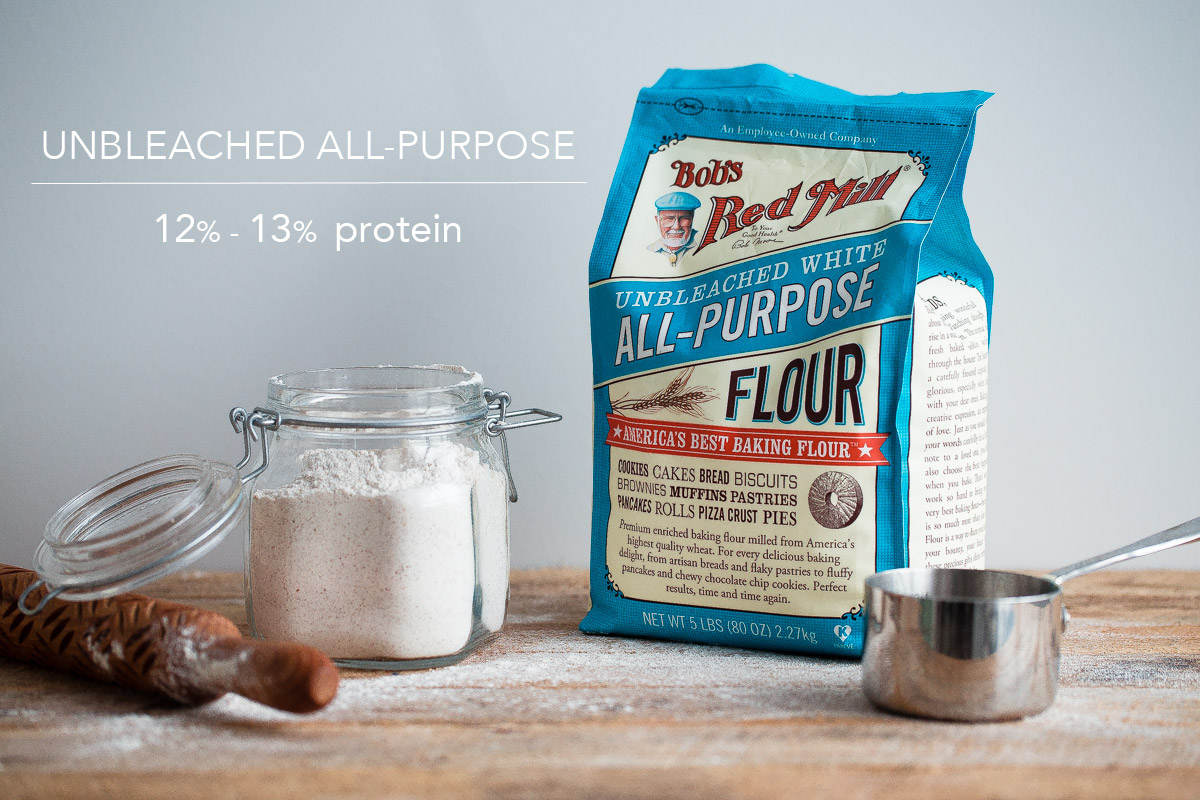
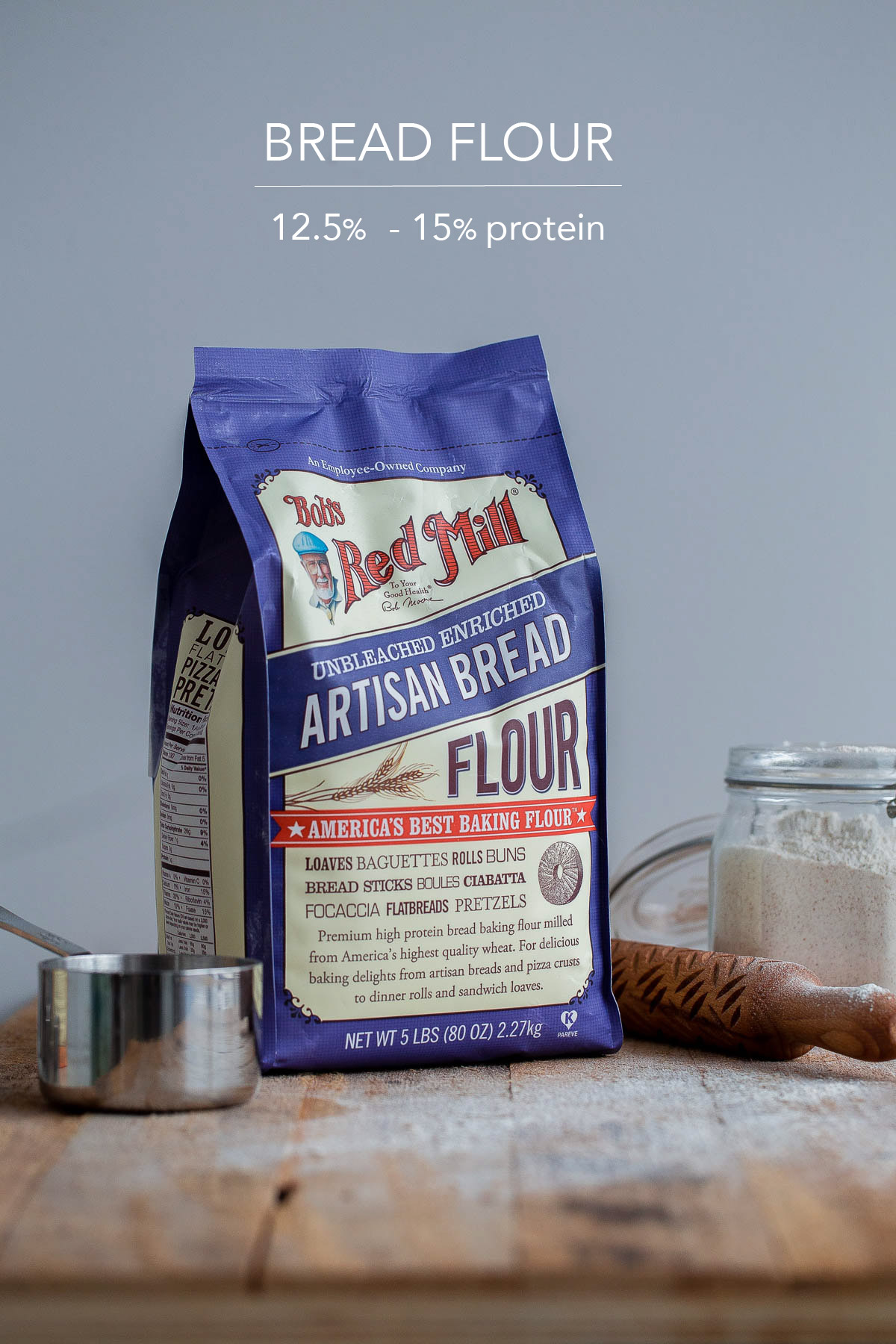
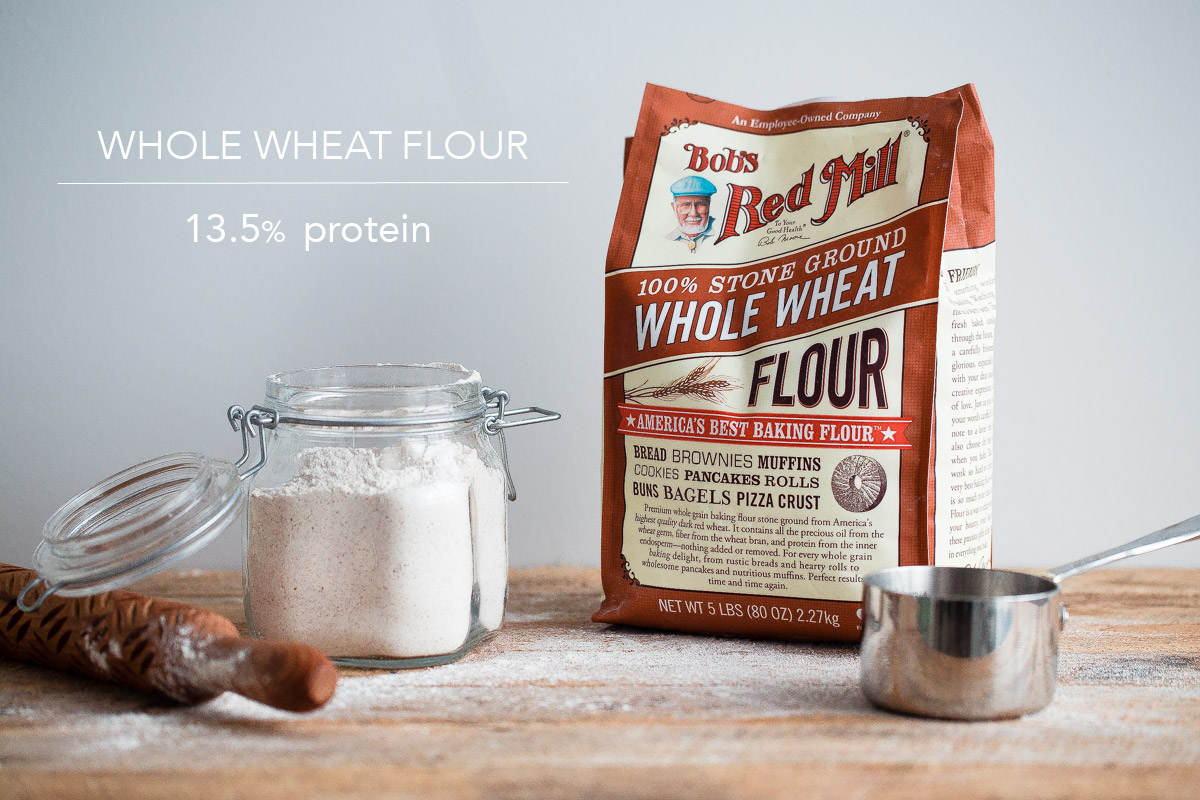
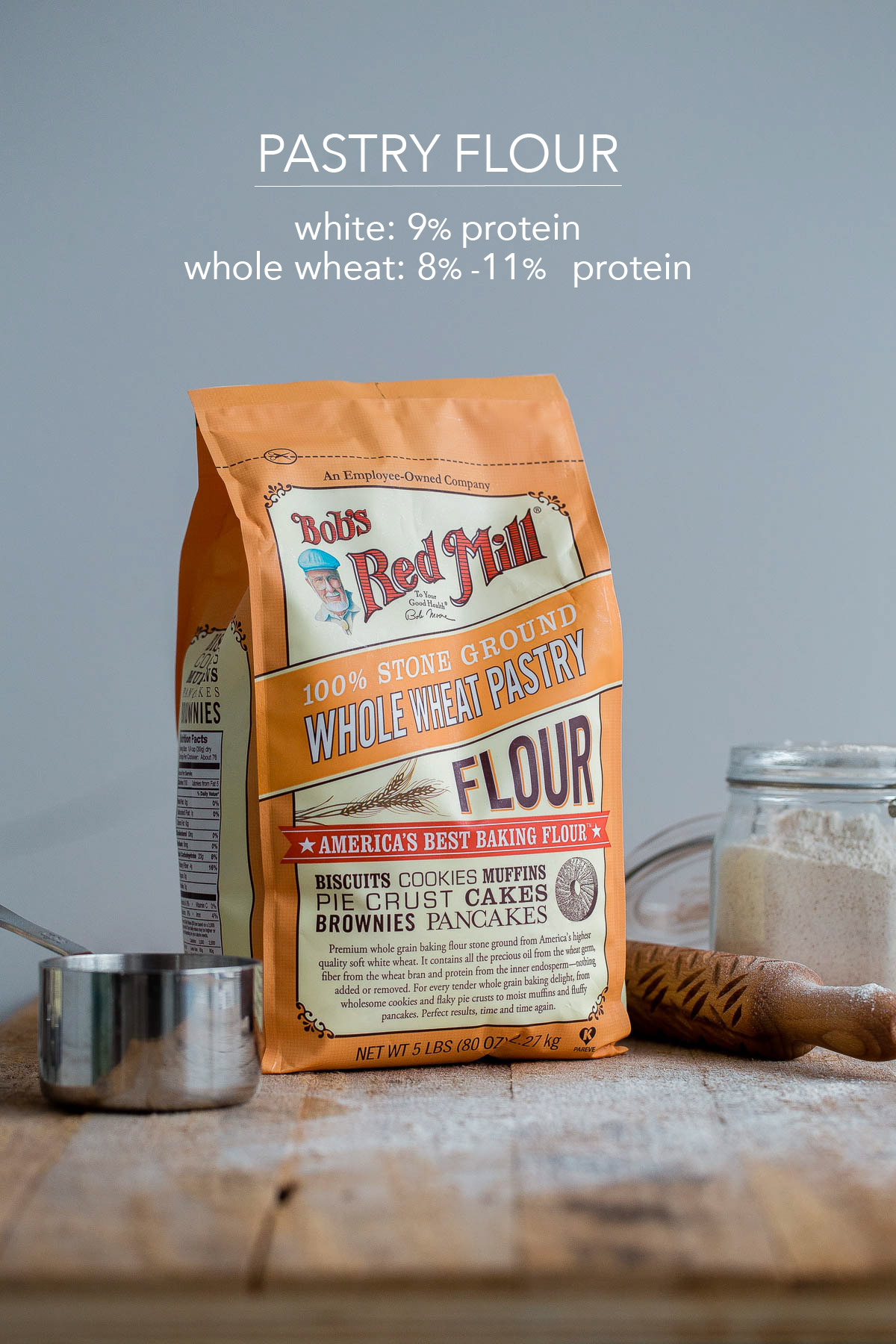
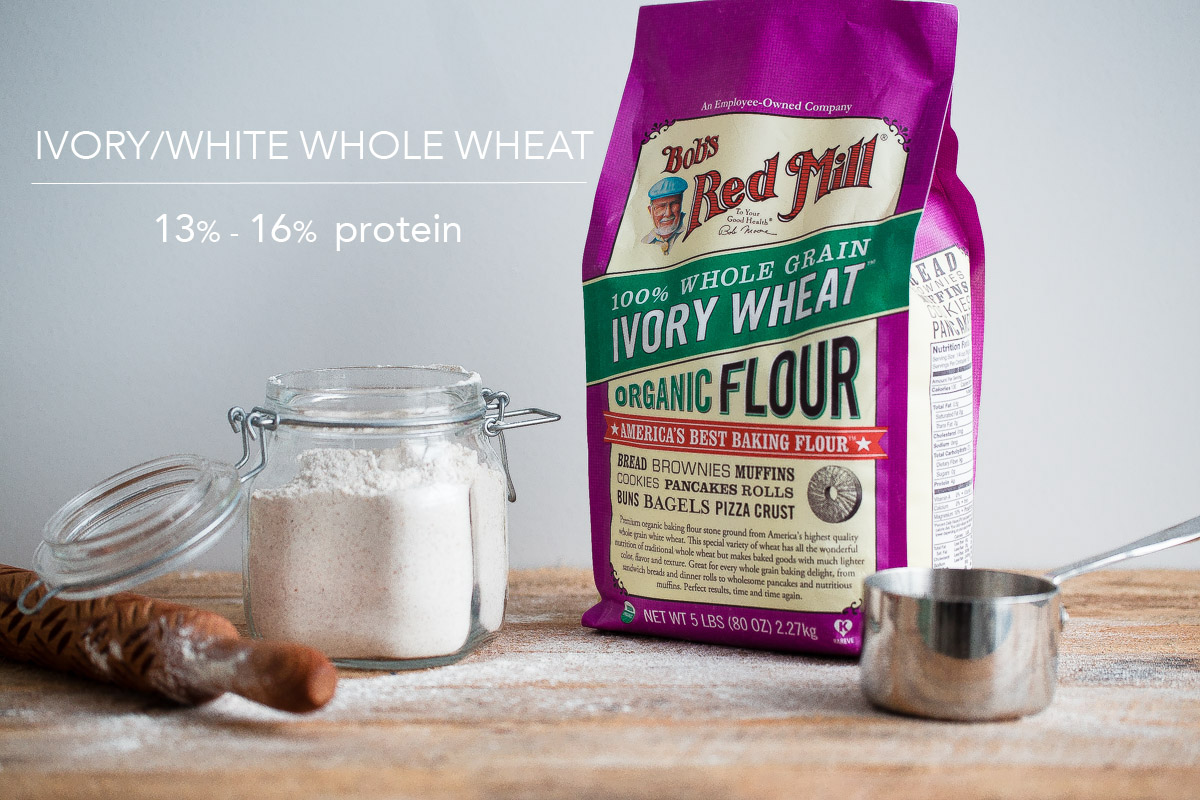
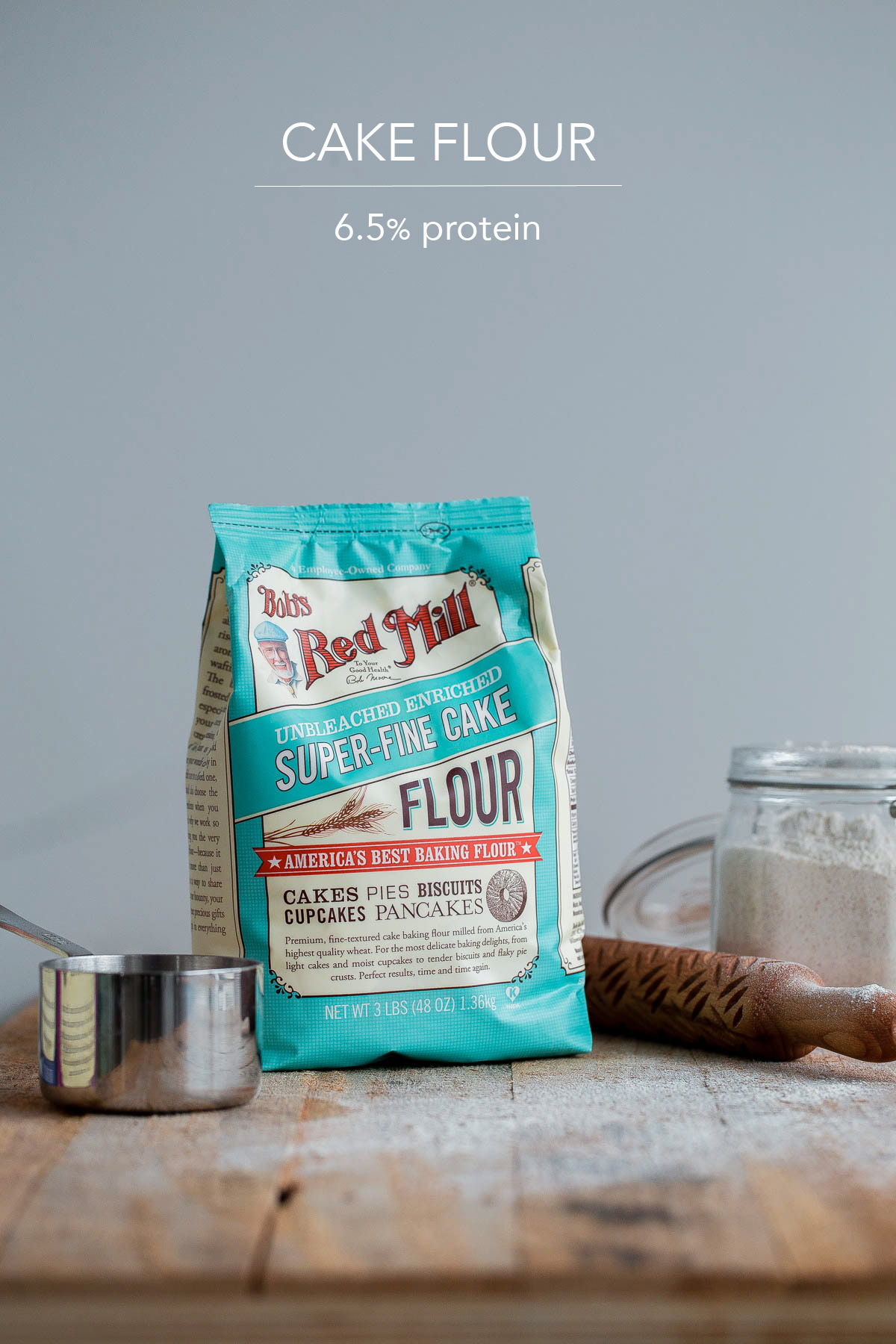
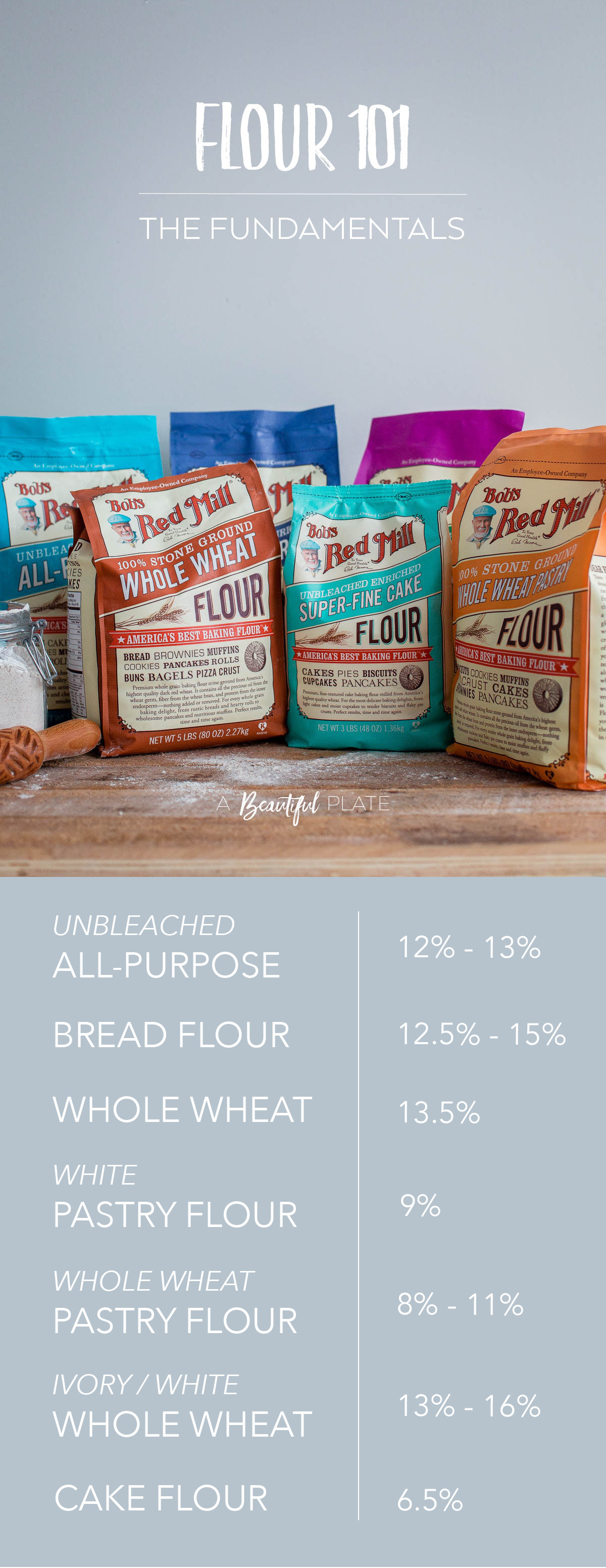
41 Comments on “Flour 101: Different Types of Flour and When to Use Them”
Hi! Would you know what the US equivalent of the type M flour found in Greece is? Thanks
Thank you so much for this post. I never really understood the whole gluten thing and how it is/was important to baking until I read this. Wow, this has opened my eyes to a whole new world of baking. Thank you, thank you!
I’m so glad it as helpful and interesting to you!
The Bread Flour from BRM contains added malted barley flour. What does this do to the fermentation and baking process, particularly in the case of sourdough?
Thank you!
Hi Will! Malted barley flour helps assist with yeast fermentation, but I have not seen any dramatic differences in sourdough breads made with BRM vs. flour brands that do not add malted barley flour. There are so many other factors – not to mention oven temperature and baking vessel – that play more of a central role, I think it would be very hard to quantify or study.
It would be much easier to test differences by testing a traditional (commercial) yeast bread side by side. I haven”t had the chance to do that either. Hope this helps!
Very informative post. I was looking for such a nice article for a long time. Thanks which flour should I use for making Indonesian martabak (egg pan cakes) or Malaysian canai roti.
I’m not personally familiar enough with those baked goods to be able to advise this! I recommend doing some google searching and finding an authentic recipe or resource for this information!
I am wanting to make homemade Italian bread. I don’t have bread flour on hand. Should I use APF or Whole Wheat Pastry Flour? & depending on your substitute recommendation, are the measurements 1:1? Thanks for the help! Wonderful, educational read.
You do not want to use pastry flour for any type of bread, as it is a low-protein flour blend that doesn’t lend itself to good gluten structure (why it’s great for cakes, but not breads). If you don’t or can’t buy bread flour, the next best option would be something like All Purpose Flour (don’t use bleached) – and you could do 1:1 substitute. You may want to reduce the hydration by a touch as well, because all purpose doesn’t absorb quite as much water as bread flour, but it’s not 100% necessary.
Glad it was helpful!
Brilliant article! You have shed so much light on the mysteries of an under-appreciated crop and how it contributes to such an array of different flours. I always wondered how one plant can have a wide range of protein concentration…
Great post! What is the US equivalent of the Type M flour found in Europe which is excellent for breads and phyllo dough? My mom is using that in Greece to make the best phyllo for pies and cannot replicate here in the States. Thanks!
Such wonderful information and easy to understand. You’re a blessing for taking the time to share. Thank you. Onto Salt 101!
Glad you enjoyed it!
I have used this brand but have started using( King Arthur flours) all unbleached in many differant varieties from A. P. to 00 flrs.( KingArthurFlour.com)and the company is 100% employee owned( Vermont).I have not been disappointed over the last 5 years. You do give a greater view on the subjects such as this one and it is wonderful to see this .You do cover it all. I love making bread and experimenting with flours of all kinds and oooh that lovely sour dough ,beer pizza dough and so much more .Thank you so much.
I personally use all your flours and I love them! I am wanting to know if you have a flour that can be used as a substitute for 00 flour. Where can I buy it?
Hi Cyndee! Thanks for your comment! 00 flour refers to the grind for the most part. It is a super fine flour that generally is about 12.5% protein. The closest alternative if you can’t find it is to use an unbleached all-purpose or perhaps a bread flour. However, you can buy 00 flour on Amazon and online now! I recommend Caputo brand: https://amzn.to/2Ka5sis
Hope this helps!
Can I use unbleached pizza flour to make bread and scones? I now use an all purpose flour but want to switch to unbleached.
Hi Kris! Are you referring to OO flour when you say unbleached pizza flour? If so, I would definitely not recommend substituting it because it has a much lower protein level and has different absorption properties that wouldn’t allow you to directly substitute. I would just recommend an unbleached all purpose flour, which is readily available, or bread flour for bread. Or alternatively, a whole wheat pastry flour for scones.
Thank you Laura! I am just looking for a flour with fewer additives to make my scones, but I still want a nice light scone. Maybe Organic all purpose might be the best bet for me.
Yes – organic will always be unbleached but there are also a lot of other non-organic unbleached flours too! I would go with an all purpose based on what you think you want to use it for…
Is Bread Flour still good past the Used by Date” Date was May 19, 2018
It really depends on how you store it, but I would probably recommend tossing it – it might have gone rancid or there could be bugs in it :/
Hi Laura! I couldn’t find whole wheat pastry flour in the UK. Would you happen to know what name is it available by or what flour is a good substitute?
Unfortunately, I don’t know the British equivalent of whole wheat pastry flour in the UK! I *think* UK plain flour is lower in protein than the US all purpose equivalent, so you might be able to get away with whole wheat plain flour?! Or a mixture of that and some lower protein flour. Sorry I can’t be more helpful!
Hi Laura. What type of flour creates a more darker crust?
Sugar helps develop a darker crust, but it can also be affected by how the moisture level, gluten development, and general baking approach.
Laura this is a great post and a beautiful work! All the information we need regarding the different types of flour and the use of it, in one post. Thank you for sharing it with us! Pinned it and shared it already 🙂
Wow, thank you so much for putting this post together, Laura! It was fascinating and I learned so much! I am so excited to start experimenting more with different flours and I’m definitely going to test out bread flour in my next batch of cookies!
So glad you enjoyed it! Here is a good resource if you might want to try bread flour in cookies: http://www.livestrong.com/article/459304-all-purpose-flour-vs-bread-flour-baking-cookies/
This was such a great read! I always struggle with when to use whole wheat vs. whole wheat pastry flour— so this post was definitely much needed on my end 🙂
Thanks so much Liz!!! So glad you found it helpful!
What a great post! Pinned for future reference 🙂
Thank you, thank you!
Okay, this post is amazing! I totally geek out about this kind of stuff – glad to know I’m not alone 😉 Yay, Bob’s!
Thank you so much Alexa!!! I do too – love food science so much!
I recently purchased 00 flour and was hoping to make thin pizza crust. Could you give some info on this type of flour and uses for it. I read your post religiously and love learning from you!
Thank you so much Patti! I’m so glad you found this interesting and informative! I had a lot of fun writing it.
Ok, so 00 flour is also a wheat flour (I just didn’t include it, because it is not as commonly found in most US supermarkets). BUT it is considered by many to be best for pizza dough (or pasta) making! The ’00’ is indicative of how finely ground the flour is – and 00 flour is incredibly fine – similar to cake flour almost. Much more fine than all-purpose flour or other flours listed above. It has low absorption, so if you are substituting it for all-purpose, you’ll have to reduce the liquid quantity as well.
There is a false understanding that 00 flour is low protein, but it is actually not – it is generally higher. If you see a ‘low protein’ 00 flour, it is not a good choice as it will behave completely different than a traditional 00 flour found in Italy. The protein content of 00 flour really depends on the brand (and which strain of wheat is made from, as it can vary), but should be around 11%-12.5%.
The higher protein lends itself to chewier crusts that can hold more gas/air. The fine-ness of the flour lends itself to very soft dough that are relatively easier to work with (in my experience than all-purpose flour) and can expand a lot once baked. However, the the hydration (amount of water), handling will affect the texture of pizza just as much as the flour type too. Hope this helps! Here is a great resource if you’re looking to read more:
http://slice.seriouseats.com/archives/2011/06/the-pizza-lab-on-flour-foams-and-dough.html
Great explanations for all the different types of flour! I like to bake with whole grains but have never tried whole wheat pastry flour. I will keep an eye out for it while shopping, Thanks!
You would love it! It yields super tender pastries, and can be substitute 1:1 with all-purpose in most things. I use it for everything, but pancakes, muffins, and quick breads are my go-to.
Fantastic post, many bakers don’t realize there is a science to baking that sometimes you just need to know to get the most out of your baking efforts, again, loved this post!
Thank you so much Diane! Totally agree – baking is 100% a science. I find it fascinating, so I’m so glad you enjoyed this post too. Thanks for the feedback!